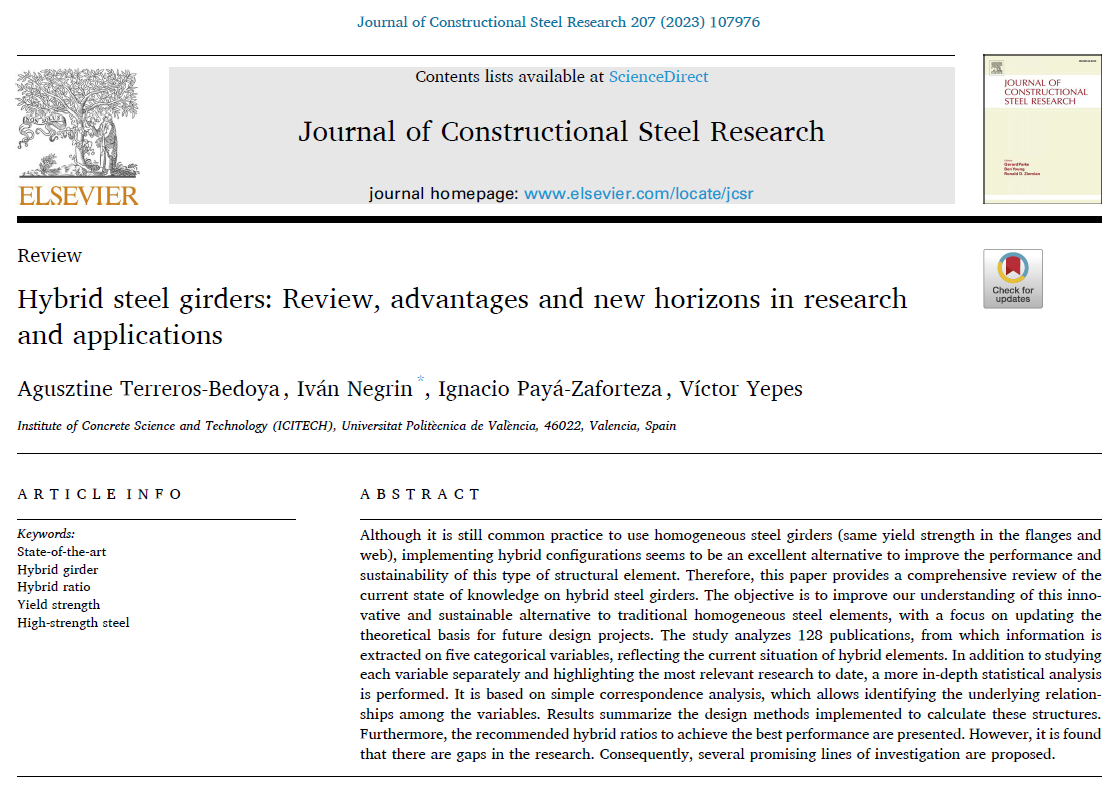 Acaban de publicarnos un artículo en el Journal of Constructional Steel Research, revista indexada en el JCR. Este artículo proporciona una revisión exhaustiva del estado actual del conocimiento sobre las vigas de acero híbridas, que son una alternativa innovadora y sostenible a los elementos de acero homogéneos tradicionales. El trabajo se enmarca dentro del proyecto de investigación HYDELIFE que dirijo como investigador principal en la Universitat Politècnica de València.
Acaban de publicarnos un artículo en el Journal of Constructional Steel Research, revista indexada en el JCR. Este artículo proporciona una revisión exhaustiva del estado actual del conocimiento sobre las vigas de acero híbridas, que son una alternativa innovadora y sostenible a los elementos de acero homogéneos tradicionales. El trabajo se enmarca dentro del proyecto de investigación HYDELIFE que dirijo como investigador principal en la Universitat Politècnica de València.
Las vigas de acero híbridas son una excelente alternativa a los elementos de acero homogéneos tradicionales, pues pueden utilizar al máximo su capacidad para hacer frente a los esfuerzos de flexión y cortante. La investigación en este campo ha ido en aumento y se han desarrollado varios métodos de diseño eficientes. Sin embargo, todavía hay algunas lagunas en la investigación que deben abordarse, como su consideración en diferentes estándares y su aplicación en estructuras de vigas complejas.
Las contribuciones de este artículo son las siguientes:
- Proporcionar una revisión exhaustiva del estado actual del conocimiento sobre las vigas de acero híbridas.
- Identificar los métodos de diseño y las proporciones híbridas recomendadas para lograr el mejor rendimiento.
- Analizar 128 publicaciones y extraer información sobre cinco variables categóricas que reflejan la situación actual de los elementos híbridos.
- Realizar un análisis estadístico basado en un análisis de correspondencia simple para identificar las relaciones subyacentes entre las variables.
- Destacar las investigaciones más relevantes hasta la fecha y proponiendo varias líneas de investigación prometedoras para abordar las brechas de investigación en este campo.
Abstract:
Although it is still common practice to use homogeneous steel girders (same yield strength in the flanges and web), implementing hybrid configurations seems to be an excellent alternative to improve the performance and sustainability of this type of structural element. Therefore, this paper comprehensively reviews the current knowledge of hybrid steel girders. The objective is to improve our understanding of this innovative and sustainable alternative to traditional homogeneous steel elements, focusing on updating the theoretical basis for future design projects. The study analyzes 128 publications, from which information is extracted on five categorical variables, reflecting the current situation of hybrid elements. In addition to studying each variable separately and highlighting the most relevant research to date, a more in-depth statistical analysis is performed. It is based on simple correspondence analysis, which allows for identifying the underlying relationships among the variables. Results summarize the design methods implemented to calculate these structures. Furthermore, the recommended hybrid ratios to achieve the best performance are presented. However, it is found that there are gaps in the research. Consequently, several promising lines of investigation are proposed.
Keywords:
State-of-the-art; Hybrid girder; Hybrid ratio; Yield strength; High-strength steel
Reference:
TERREROS-BEDOYA, A.; NEGRÍN, I.; PAYÁ-ZAFORTEZA, I.; YEPES, V. (2023). Hybrid steel girders: review, advantages and new horizons in research and applications. Journal of Constructional Steel Research, 207:107976. DOI:10.1016/j.jcsr.2023.107976.
Al tratarse de un artículo publicado en abierto, os dejo el mismo para su descarga. Espero que os sea de interés.
